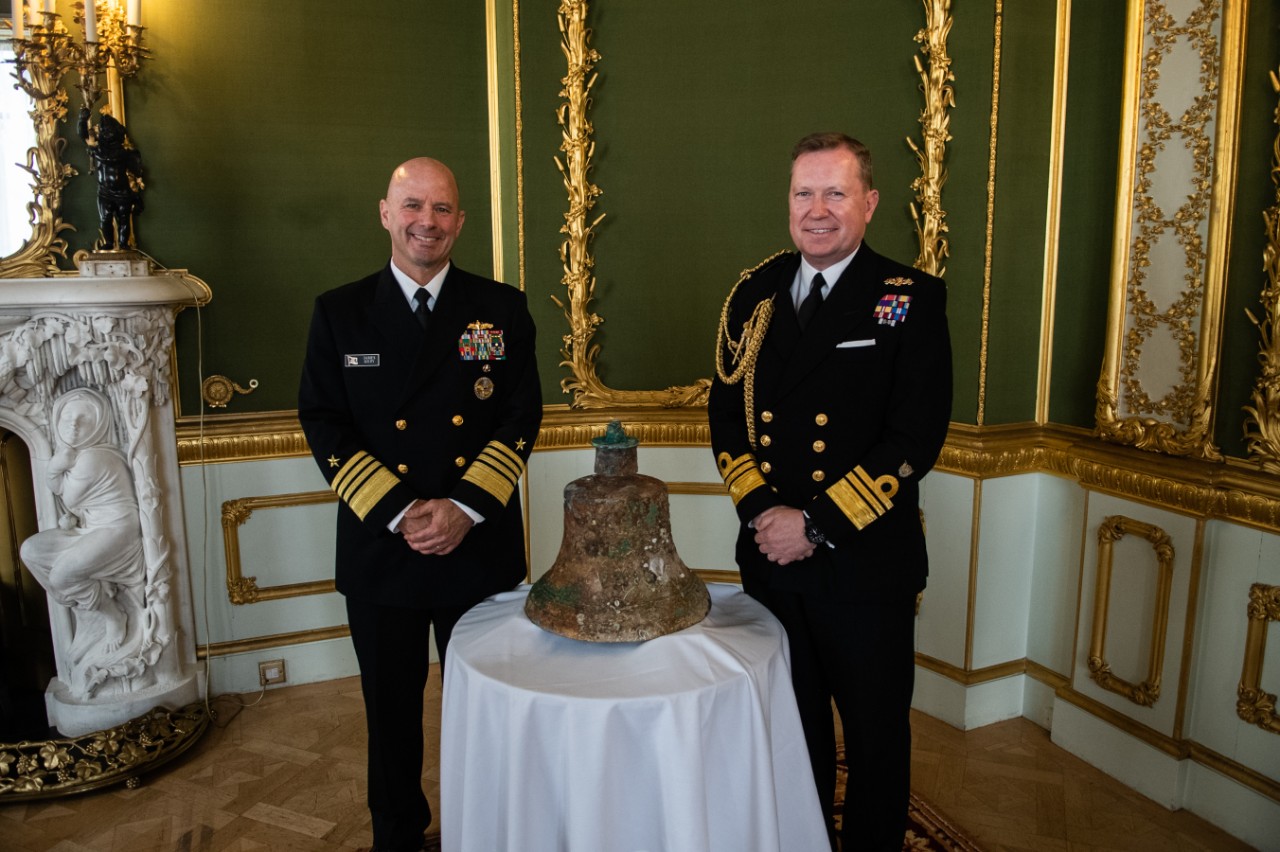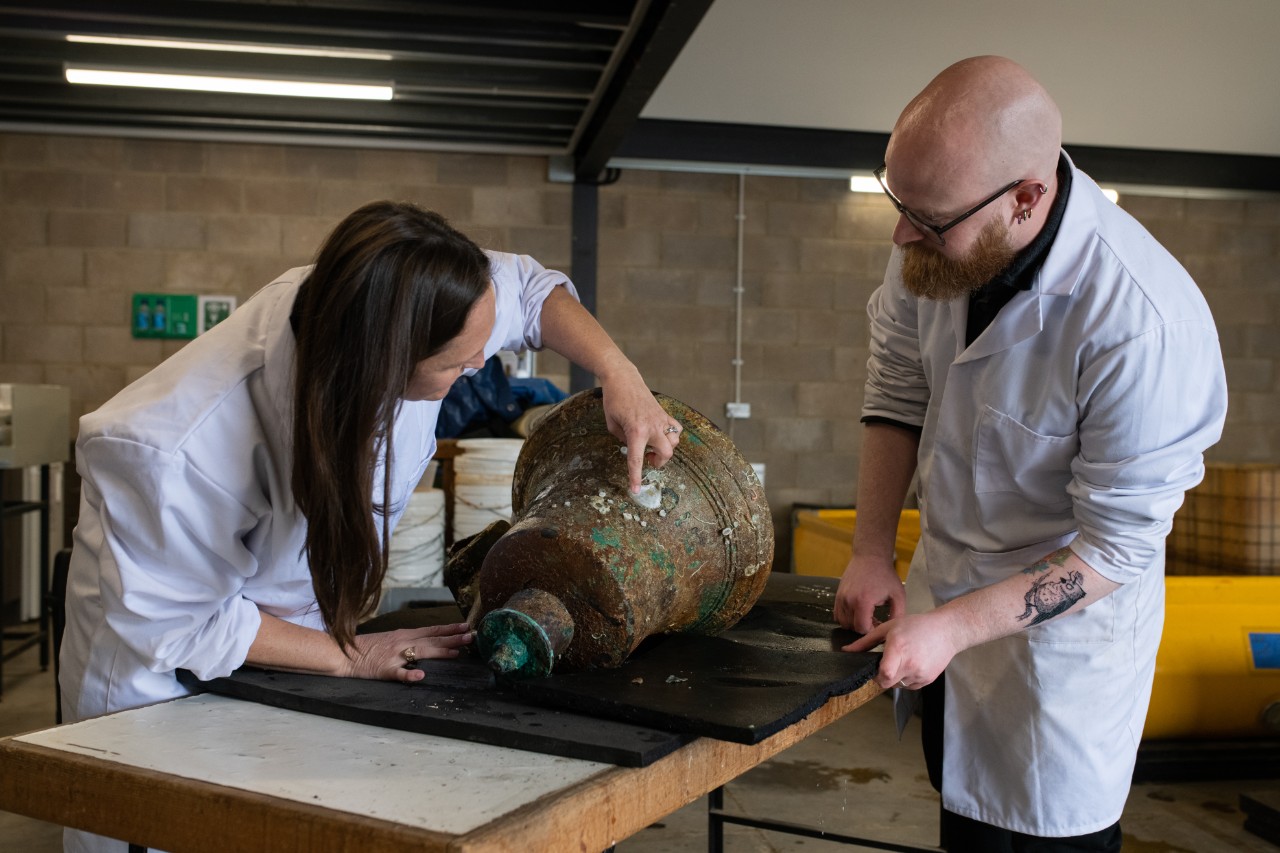
LONDON (May 15, 2024) Adm. Jim Kilby, vice chief of naval operations, left, and U.K. U.K. Vice Adm. Martin Connell, second sea lord and deputy chief of naval staff, with the ship’s bell of USS Jacob Jones (DD 61) during a ceremony in Lancaster House transitioning the bell from the U.K. to the U.S. Navy in London, May 15, 2024. The bell – recovered in January by the United Kingdom Ministry of Defence’s Salvage and Marine Operations (SALMO) team with support from Naval History and Heritage Command (NHHC) –is intended for display in the future new National Museum of the U.S. Navy following conservation efforts. (U.S. Navy photo by Mass Communication Specialist 1st Class Jonathan Nelson/Released)
by Monica McCoy, NHHC Communication and Outreach Division
Vice Chief of Naval Operations Adm. Jim Kilby received the ship’s bell of USS Jacob Jones (DD 61) on behalf of the U.S. Navy from the U.K. Royal Navy’s Second Sea Lord Vice Adm. Martin Connell during a ceremony at Lancaster House in London, England, May 15.
“Bells have huge significance and symbolism. They are a central part of our ships,” said Connell. “When I was fortunate enough to command an aircraft carrier, the ship’s name was HMS Illustrious, it was the fifth named ship. The fourth ship was also an aircraft carrier and received action damage in the Second World War. That bell from that fourth ship sat outside my cabin, and it was a daily reminder sort of to me and all of my Sailors about what happens in war. This bell was ripped apart with the blast damage that it received at the time. That bell now sits in the Chief of Naval Operations’ dining room in the Pentagon. It is another symbol of the U.K., U.S., Royal Navy, United States Navy relationship.”
“This bell serves as a remembrance of the 64 Sailors aboard Jacob Jones who made the ultimate sacrifice defending the freedom of our country and those who challenged it,” said Kilby. “As the first U.S. destroyer lost in combat, her crew’s legacy will live on, their stories will be told and their loss will be remembered as we preserve this piece of our nation’s story. Our Navy expresses our sincerest gratitude to those who made it possible to take this incredible artifact of somber history back home.”

SALISBURY, England (May 14, 2024) The ship’s bell of USS Jacob Jones (DD 61) in a tub of water at Wessex Archaeology in Salisbury, England, May 14, 2024. The bell – recovered in January by the United Kingdom Ministry of Defence’s Salvage and Marine Operations (SALMO) team with support from Naval History and Heritage Command (NHHC) – was initially stabilized by Wessex Archaeology and is intended for display in the future new National Museum of the U.S. Navy following conservation efforts. (U.S. Navy photo by Mass Communication Specialist 1st Class Jonathan Nelson/Released)
USS Jacob Jones (DD 61) was the first U.S. Navy destroyer lost to enemy action, sinking eight minutes after being struck by a torpedo fired from German submarine U-53 on Dec. 6, 1917. Out of the seven officers and 103 men on board at the time of the attack, 64 lost their lives.
The shipwreck was discovered off the Isles of Scilly, England, in August 2022 by technical divers. Since the discovery, multi-lateral efforts involving SALMO, the UK’s National Oceanography Centre, Wessex Archaeology, and NHHC aim to fully document and study the wreck site in support of its interpretation and long-term preservation. The continued cooperation between the UK Ministry of Defence and the U.S. Navy fortifies the historical bonds and mutual dedication to honoring and preserving a shared naval history.
The bell – recovered in January 2024 by the United Kingdom Ministry of Defence’s Salvage and Marine Operations (SALMO) team with support from NHHC – was initially stabilized by Wessex Archaeology. Following NHHC Underwater Archaeology branch conservation efforts, the bell is intended for display in the future new National Museum of the U.S. Navy.
“NHHC’s goal is to document and preserve this artifact in the Command’s Conservation, Research, and Archaeology Laboratory and prepare it for long-term curation and display in the new National Museum of the U.S. Navy. We believe the bell will offer a tangible way for the public to connect and learn about the story of Jacob Jones and U.S. Navy’s role in World War I,” said NHHC Archaeological Conservator Shanna Daniel.
“We’re incredibly grateful to everyone who made this important recovery possible,” said NHHC Director, Sam Cox, retired U.S. Navy Rear Adm. “World War I marked a pivotal moment in our collective history. In escorting convoys of soldiers and supplies across the Atlantic, the Jacob Jones contributed significantly to the ultimate Allied victory. The ultimate sacrifice of many of her crew demonstrates that victory has a cost, and freedom isn’t free. We should never forget these courageous sailors. The remains of the ship are a war grave, and it is normally Navy policy to leave such wrecks undisturbed. However, due to significant risk the bell could be plundered, this recovery represents an exceptional case. After final conservation the bell of the Jacob Jones will be displayed in the National Museum of the United States Navy in honor of the gallant crew of this ship, and especially the 64 men who did not survive.”
The wreck of USS Jacob Jones (DD 61) is a U.S. sunken military craft protected by U.S. law and under the jurisdiction of the Department of the Navy. While non-intrusive activities, such as remote sensing documentation, on U.S. Navy sunken military craft are allowed, any activity that may result in the disturbance of a sunken military craft must be coordinated with NHHC and, if appropriate, authorized through a relevant permitting program. Most importantly, the wreck represents the final resting place of Sailors who gave their life in defense of the nation and should be respected by all parties as a war grave.
For more information regarding the sinking of USS Jacob Jones (DD 61), visit: www.history.navy.mil/research/underwater-archaeology/sites-and-projects/ship-wrecksites/uss-jacob-jones-dd-61.html

SALISBURY, England (May 14, 2024) Shanna Daniel, lead archaeological conservator at Naval History and Heritage Command (NHHC), left, and Thomas Wicks, conservator at Wessex Archaeology, prepare the ship’s bell of USS Jacob Jones (DD 61) for conservation at Wessex Archaeology in Salisbury, England, May 14, 2024. The bell – recovered in January by the United Kingdom Ministry of Defence’s Salvage and Marine Operations (SALMO) team with support from NHHC – was initially stabilized by Wessex Archaeology and is intended for display in the future new National Museum of the U.S. Navy following conservation efforts. (U.S. Navy photo by Mass Communication Specialist 1st Class Jonathan Nelson/Released)
NHHC, located at the Washington Navy Yard, is responsible for preserving, analyzing, and disseminating U.S. naval history and heritage. It provides the knowledge foundation for the Navy by maintaining historically relevant resources and products that reflect the Navy's unique and enduring contributions through our nation's history and supports the fleet by assisting with and delivering professional research, analysis, and interpretive services. NHHC comprises many activities, including the Navy Department Library, the Navy Operational Archives, the Navy art and artifact collections, underwater archeology, Navy histories, 10 museums, USS Constitution repair facility, and the historic ship Nautilus.


